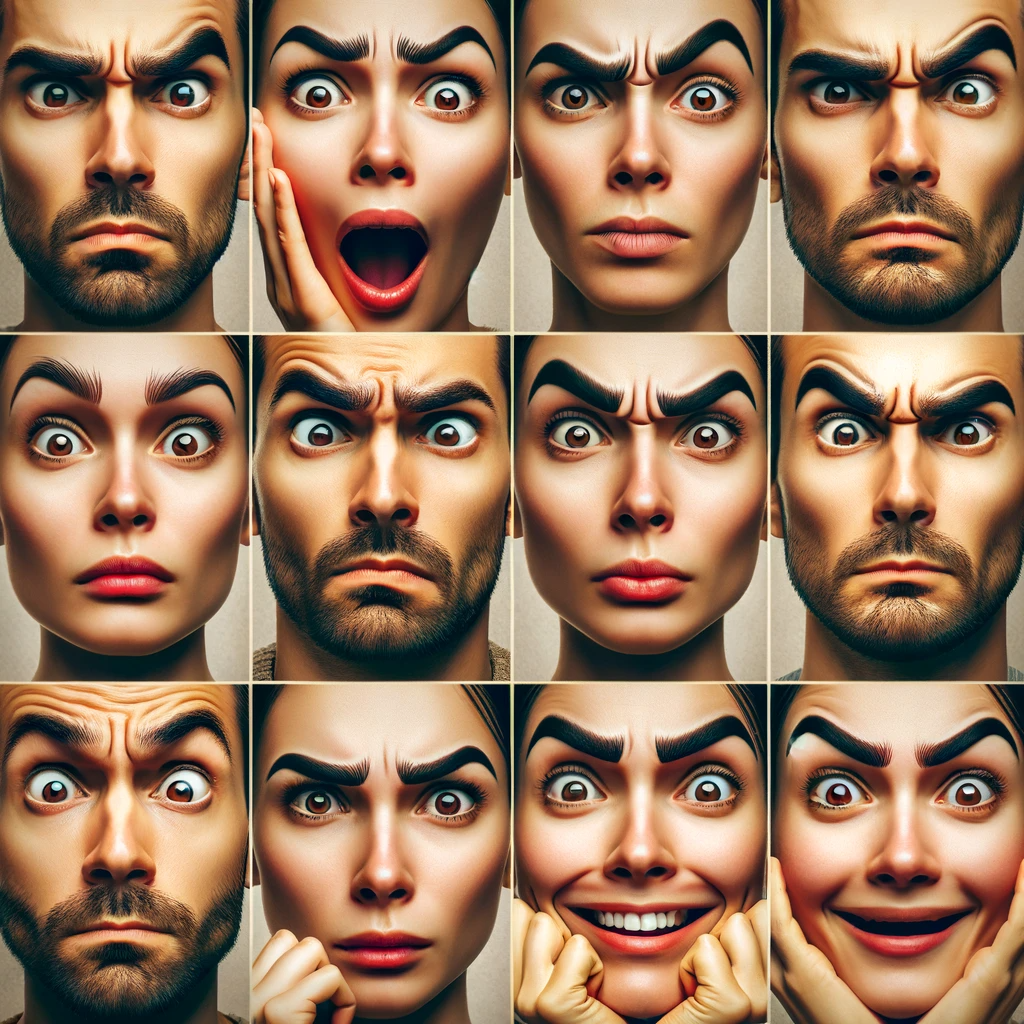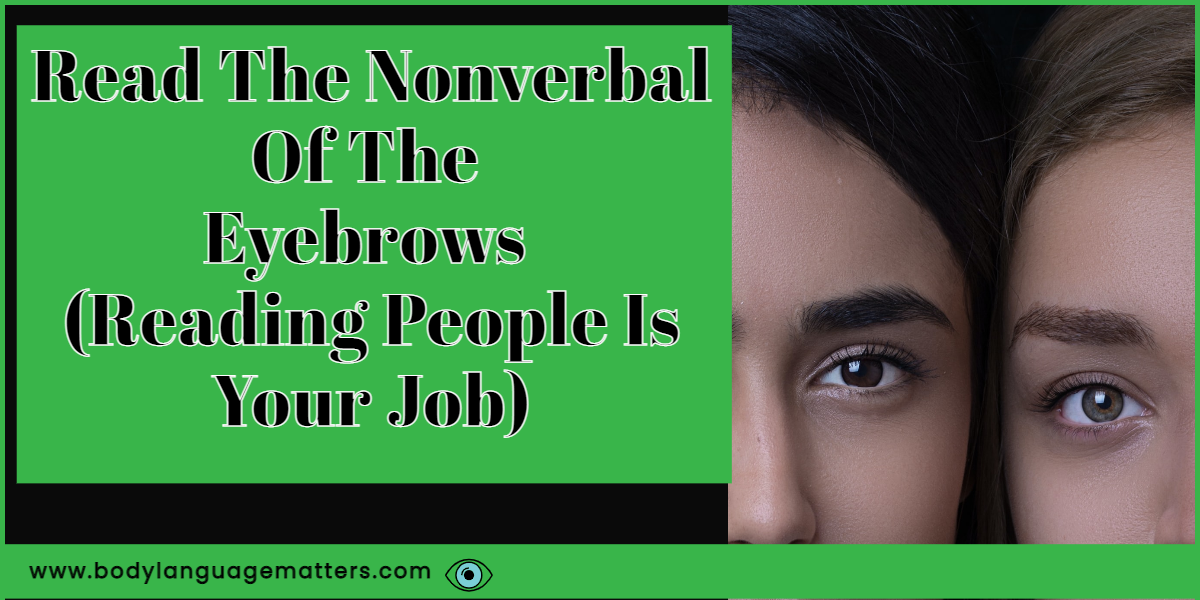Have you ever noticed how much your eyebrows say without you speaking a word? It’s fascinating! Eyebrows play a big role in showing our emotions and thoughts. They move in special ways to express feelings like surprise, confusion, or even disbelief.
It’s like having a secret language right on our face. Let’s dive into the world of eyebrows and discover how these simple movements can tell us so much about what someone is really thinking or feeling.
In this article we look at how to read the eyebrows and what to look out for in non-verbal communication to make you a better communicator altogether.
Table of Contents
Understand The Eyebrows

Quick Guide
- “Eyebrow Flashing: A Gesture of Greeting and Recognition”
- Used to Say Hello or Recognize Someone
- “Eyebrow Raising: Expressing Surprise
- How Lifting Your Eyebrows Shows Shock or Curiosity Without Speaking
- “Eyebrow Lowering: Indications of Dominance or Aggression”
- The Nuances of Lowering Eyebrows: Signs of Control or Anger
- “Eyebrow Knitting: A Universal Signal of Concentration or Concern”
- Furrowing Your Eyebrows: A Common Way to Show Focus or Worry
- “The Eyebrow Arch: Conveying Curiosity and Skepticism”
- Raising One Part of the Eyebrow: Showing Doubt or Interest
Eyebrow Flashing (A Gesture of Greeting and Recognition)
Eyebrow Flash (Relaxed)

- Context: Greeting a friend.
- What to Look For: A quick, almost imperceptible lifting of the eyebrows. It usually lasts only a fraction of a second.
- Example: You’re walking down the street and you spot a friend across the road. As you wave, you notice their eyebrows quickly rise and fall. This is an eyebrow flash, a non-verbal way of saying, “Hello, I see you!”
When someone raises their eyebrows when they see you usually means “Hello” when we greet someone for the first time or recognize someone we will usually raise our eyebrows to show that we know them or recognize them.
Police investigators will use this as a tactic to tell if two people recognize one another. They will have two suspects walk past each other or allow a glance through a window to see if the eyebrows raise. You can try this out for yourself.
The next time you are walking around town or at work, simply raise your eyebrows as you make eye contact, say nothing. You should get a response or the same gesture back.
This is a cool bit of knowledge to know, it helps build rapport faster and helps people relax around you.
Eyebrow Raising (Expressing Surprise)
Eyebrow Raising (Tense)

- Context: Receiving unexpected news.
- What to Look For: The eyebrows pull together and arch upward, often causing wrinkles on the forehead. This expression is held for a few seconds longer than an eyebrow flash.
Example: Imagine you’re checking out at a store and the total is much higher than you anticipated. You might find your eyebrows arching as you question the cashier, reflecting your surprise and concern.
Now, let’s flip the scenario. You’re in a meeting at work, and your boss unexpectedly criticizes your project in front of everyone. You might feel a rush of anxiety or embarrassment, and without even thinking, your eyebrows arch and remain raised for a few seconds longer than the quick flash.
This “eyebrow arching” is your body’s way of signaling that you’re tense or caught off guard. It’s like your face is saying, “Wait, what just happened?”
Eyebrow Lowering (Indications of Dominance or Aggression)
Eyebrow Arching (Tense)

Eyebrow lowering can be a powerful non-verbal cue that signals dominance or aggression. This facial expression can be used consciously or unconsciously in various situations to assert control or express displeasure. Here’s what to look out for in real-world scenarios:
- Context: A heated debate or argument.
- What to Look For: The eyebrows draw down and together, causing creases to appear between them. The eyes may narrow, and the gaze can become more intense or staring.
- Example: In a meeting where there’s a disagreement, one person might lower their eyebrows while making a point. This can be a sign that they’re asserting authority or showing frustration towards the opposing viewpoints.
- Context: Competitive environments, like sports or business negotiations.
- What to Look For: A sustained furrowing of the eyebrows, not just a fleeting movement, often accompanied by a hardening of the jawline and a forward lean of the body.
- Example: Two athletes might lower their eyebrows when facing off, each trying to intimidate the other and gain a psychological edge.
- Context: Responding to a challenge or threat.
- What to Look For: The eyebrows come down and forward, shading the eyes slightly. This can create a “hooding” effect that is often perceived as menacing or confrontational.
- Example: If someone feels their personal space is being invaded, they might respond with lowered eyebrows, signaling to the other person to back off.
Eyebrow lowering in the context of dominance or aggression serves as a non-verbal assertion of space, power, or status. It can be a signal for others to take notice that a person is not to be trifled with. Recognizing this expression can be crucial in understanding power dynamics within interactions and responding appropriately.
Eyebrow Knitting (A Universal Signal of Concentration or Concern)
Eyebrow Knitting (Tense)

Eyebrow knitting, often referred to as furrowing, is a universal non-verbal signal indicating deep concentration, concern, or confusion. It’s characterized by the eyebrows drawing closer together, creating vertical lines between them. This expression can be a response to a variety of situations requiring mental focus or emotional response. Here are some examples to look for in everyday life:
- Context: Solving a complex problem.
- What to Look For: The eyebrows pull toward each other, creating a furrowed look on the forehead. The person may also have a focused gaze.
- Example: You’re working on a difficult math problem and find yourself knitting your eyebrows as you concentrate on finding the solution.
- Context: Experiencing concern or worry.
- What to Look For: Along with the eyebrows drawing together, there might be a slight frown and the person may look down or away from others.
- Example: Hearing unsettling news, you might instinctively knit your eyebrows as you process the information and worry about the implications.
- Context: Trying to comprehend complex information or instructions.
- What to Look For: The eyebrows are drawn together, and there might be a slight head tilt as if trying to make sense of the information being presented.
- Example: During a lecture with difficult material, you notice several students with their eyebrows knit, indicating their effort to understand the content being discussed.
Recognizing the knit eyebrows in others can be a cue to offer assistance or clarification, or it can signal that it’s time to give someone space to think. On a personal level, becoming aware of your own eyebrow knitting can help you understand your reactions to stress or challenging tasks and manage them more effectively.
Eyebrow Raising (Tense)

The Eyebrow Arch: Conveying Curiosity and Skepticism
The eyebrow arch is a nuanced expression that can convey a range of emotions from curiosity to skepticism. This non-verbal cue is characterized by one or both eyebrows raising, creating a curved arch above the eye. Here are some examples of when you might observe this gesture in everyday interactions:
- Curiosity:
- Context: Hearing an interesting fact or story.
- What to Look For: One eyebrow may raise higher than the other, or both may lift slightly, reflecting an open and inquisitive state of mind.
- Example: You’re listening to a friend talk about their adventures abroad, and you find yourself arching an eyebrow as you’re drawn into the fascinating details of their journey.
- Skepticism:
- Context: Questioning the truthfulness or validity of a statement.
- What to Look For: The arch may be more pronounced, often accompanied by a slight tilt of the head, and possibly a pause as if weighing the information.
- Example: Someone makes a claim that seems too good to be true, and you respond with a raised eyebrow, signaling your doubt and prompting them to provide more evidence.
- Surprise Mixed with Skepticism:
- Context: Reacting to an unexpected turn of events that seems suspicious.
- What to Look For: A sharp arch of the eyebrows along with wide eyes, indicating both astonishment and a hint of disbelief.
- Example: You hear a sudden change in plans that seems abrupt, and your eyebrows arch as you try to make sense of this new information, wondering if there’s more to the story.
The eyebrow arch is a versatile expression, and its meaning can change depending on the context and accompanying facial expressions. It’s a subtle but powerful way to communicate a complex mix of emotions without saying a word.
Why You Need To Understand Context First.
According to Google, the noun context can be described as “the circumstances that form the setting for an event, statement, or idea and which it can be understood.”
This is a perfect example of what context really means. The context will help us gather information about what is going on in someone’s mind, which in turn will help us figure out what’s happening with them.
We will take a deep dive into what they really mean in this article on nonverbal cues of the eyebrows.
Frequently Asked Questions
Is Raised Eyebrows A Sign Of Attraction?
When someone raises their eyebrows, it often means they are either really interested in what you’re saying or they’re trying to understand it better. It might also mean they find you attractive. People’s eyes usually get wider and their pupils grow bigger when they see someone they think looks good. A quick way to know if someone likes you is to see if their body language is open and relaxed around you. But if they seem closed off or their body signals are tight and guarded, it’s likely they’re not too fond of you.
What Does Raising Eyebrows Up And Down Mean
When someone moves their eyebrows up and down, it might mean they are joking around with you. It could be in a fun, friendly way, or sometimes in a not-so-nice way. But usually, we see this kind of eyebrow movement as a sign of someone being playful and in a good mood.
What Does Touching Your Eyebrow Mean?
When your hand touches your eyebrow it means you are struggling to remember something. This gesture is more prominent when someone has been thinking deeply about a topic.
This body language cue could also mean they are feeling pressured or under the stress of some kind. Body language experts call this a regulator or pacifier, it’s a way of self-soothing to bring oneself back under control.
Why Does Rubbing Eyebrows Feel Good?
The feeling of relief you get when you rub your eyebrows is due to the stimulation of nerve endings. The eyebrow muscles are connected to the occipital nerve, which is responsible for both sensation and motion near the head. So rubbing them not only feels great but also relieves tension in other areas of the body.
Asymmetry In The Eyebrows What Does It Mean.
The asymmetry in the eyebrows is when one of the eyebrows is higher than the other. This is a sign that they have doubts or feel uncertain about something. You will often see this nonverbal cue depicted in detective cartoons. The one that springs to mind is Jim Carrey in the 1994 film Ace Ventura. You see doubt or suspect a lie is being told.
You may also like
Final Thoughts
Eyebrows are really important when it comes to showing how we feel without speaking. They can tell us a lot about a person’s emotions and thoughts. By looking at someone’s eyebrows, we can often understand if they’re feeling upset, angry, sad, or happy. Eyebrows give us lots of clues about what someone is feeling inside.

